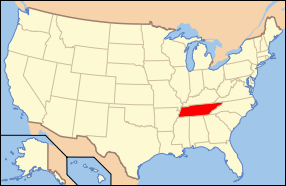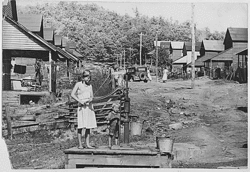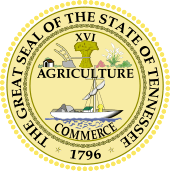Fentress County, Tennessee
| Fentress County, Tennessee | |
|---|---|
 Fentress County Courthouse in Jamestown | |
|
Location in the U.S. state of Tennessee | |
 Tennessee's location in the U.S. | |
| Founded | 1823 |
| Named for | James Fentress, state legislator[1] |
| Seat | Jamestown |
| Largest city | Jamestown |
| Area | |
| • Total | 499 sq mi (1,292 km2) |
| • Land | 499 sq mi (1,292 km2) |
| • Water | 0.3 sq mi (1 km2), 0.06% |
| Population | |
| • (2010) | 17,959 |
| • Density | 36/sq mi (14/km2) |
| Congressional district | 6th |
| Time zone | Central: UTC−6/−5 |
| Website |
www |
Fentress County is a county located in the U.S. state of Tennessee. As of the 2010 census, the population was 17,959.[2] Its county seat is Jamestown.[3]
History

Fentress County was formed in 1823 from portions of Morgan, Overton and White counties. The resulting county was named for James Fentress[4] (1763–1843), who served as speaker of the state house, chairman of Montgomery County Court, and commissioner to select seats for Haywood, Carroll, Gibson and Weakley counties in West Tennessee.[1]
Fentress County was the site of several saltpeter mines. Saltpeter is the main ingredient of gunpowder and was obtained by leaching the earth from local caves. The largest mine was in York Cave, near the Wolf River Post Office. At one time, twenty-five large leaching vats were in operation in this cave. According to Barr (1961) this cave was mined during the Civil War. Buffalo Cave near Jamestown was also a major mine with twelve leaching vats. Manson Saltpeter Cave in Big Indian Creek Valley was a smaller operation with four leaching vats. These caves may also have been mined during the War of 1812, as saltpeter mining was widespread in Kentucky and Tennessee during that era.[5]
In the runup to the American Civil War, when Tennessee Governor Harris asked the State Legislature for a vote of secession, the two representatives from Fentress County (Reese T. Hildreth and R. H. Bledsoe) voted for Secession.
Alvin York (1887–1964), a hero at the Meuse-Argonne Offensive during World War I, was born and lived in Fentress County. He established the Alvin C. York Agricultural Institute in Jamestown in 1924.[6] York's house and farm are part of Sgt. Alvin C. York State Historic Park in Pall Mall.
Geography
According to the U.S. Census Bureau, the county has a total area of 499 square miles (1,290 km2), of which 499 square miles (1,290 km2) is land and 0.3 square miles (0.78 km2) (0.06%) is water.[7]
Fentress County includes part of Dale Hollow Reservoir and is drained by forks of the Obey and Cumberland Rivers.
The county is the easternmost county in the United States to observe Central Time.
Adjacent counties

- Pickett County (north)
- Scott County (east/EST Border)
- Morgan County (southeast/EST Border)
- Cumberland County (south)
- Overton County (west)
- Putnam County (southwest)
National protected area
State protected areas
- Catoosa Wildlife Management Area (part)
- Colditz Cove State Natural Area
- Pickett State Forest (part)
- Pogue Creek State Natural Area
- Scott State Forest (part)
- Sgt. Alvin C. York State Historic Park
- Skinner Mountain Wildlife Management Area
- Twin Arches State Natural Area (part)
Demographics
| Historical population | |||
|---|---|---|---|
| Census | Pop. | %± | |
| 1830 | 2,748 | — | |
| 1840 | 3,550 | 29.2% | |
| 1850 | 4,454 | 25.5% | |
| 1860 | 5,054 | 13.5% | |
| 1870 | 4,717 | −6.7% | |
| 1880 | 5,941 | 25.9% | |
| 1890 | 5,226 | −12.0% | |
| 1900 | 6,106 | 16.8% | |
| 1910 | 7,446 | 21.9% | |
| 1920 | 10,435 | 40.1% | |
| 1930 | 11,036 | 5.8% | |
| 1940 | 14,262 | 29.2% | |
| 1950 | 14,917 | 4.6% | |
| 1960 | 13,288 | −10.9% | |
| 1970 | 12,593 | −5.2% | |
| 1980 | 14,826 | 17.7% | |
| 1990 | 14,669 | −1.1% | |
| 2000 | 16,625 | 13.3% | |
| 2010 | 17,959 | 8.0% | |
| Est. 2016 | 18,033 | [8] | 0.4% |
| U.S. Decennial Census[9] 1790-1960[10] 1900-1990[11] 1990-2000[12] 2010-2014[2] | |||

As of the 2010 census,[14] there were 17,959 people, 7,326 households, and 4,818 families residing in the county. The population density was 36 people per square mile (13/km²). There were 8,927 housing units at an average density of 15 per square mile (6/km²). The racial makeup of the county was 98.1% White, 0.2% Black or African American, 0.2% Native American, 0.2% Asian, 0.4% from other races, and 0.9% from two or more races. 1.1% of the population were Hispanic or Latino of any race.
In the county's 7,326 households, 23.1% had children under the age of 18, 57.30% were married couples living together, 11.30% had a female householder with no husband present, and 28.00% were non-families. 25.50% of all households were made up of individuals and 11.10% had someone living alone who was 65 years of age or older. The average household size was 2.46 and the average family size was 2.94.
In the county, the population was spread out with 24.20% under the age of 18, 8.00% from 18 to 24, 28.10% from 25 to 44, 26.10% from 45 to 64, and 13.70% who were 65 years of age or older. The median age was 38 years. For every 100 females there were 96.20 males. For every 100 females age 18 and over, there were 93.10 males.
The median income for a household in the county was $23,238, and the median income for a family was $28,856. Males had a median income of $23,606 versus $18,729 for females. The per capita income for the county was $12,999. 19.50% of families and 23.10% of the population were below the poverty line, including 27.80% of those under age 18 and 20.50% of those over age 64.
Communities
Cities
Census-designated places
Unincorporated communities
- Armathwaite
- Banner-Roslin
- Banner Springs
- Boatland
- Davidson
- Forbus
- Glenobey
- Little Crab
- Martha Washington
- Mount Helen
- Pall Mall
- Shirley
- Tinchtown
- Wilder
- Zenith
Politics
| Year | Republican | Democratic | Third Parties |
|---|---|---|---|
| 2016 | 82.3% 6,038 | 15.0% 1,100 | 2.7% 195 |
| 2012 | 76.0% 5,243 | 22.6% 1,561 | 1.3% 91 |
| 2008 | 71.1% 4,789 | 27.2% 1,831 | 1.8% 119 |
| 2004 | 64.1% 4,293 | 35.4% 2,371 | 0.5% 36 |
| 2000 | 56.7% 3,417 | 42.0% 2,529 | 1.4% 83 |
| 1996 | 45.6% 2,307 | 46.1% 2,332 | 8.2% 417 |
| 1992 | 41.5% 2,391 | 47.4% 2,730 | 11.1% 638 |
| 1988 | 62.2% 3,103 | 37.2% 1,856 | 0.7% 33 |
| 1984 | 62.2% 2,922 | 37.4% 1,755 | 0.5% 22 |
| 1980 | 60.8% 2,493 | 37.6% 1,543 | 1.6% 67 |
| 1976 | 47.0% 1,767 | 52.0% 1,953 | 1.0% 38 |
| 1972 | 75.5% 2,154 | 23.3% 665 | 1.2% 34 |
| 1968 | 57.8% 2,026 | 19.1% 671 | 23.1% 808 |
| 1964 | 56.0% 1,969 | 44.1% 1,550 | |
| 1960 | 71.9% 2,726 | 26.7% 1,014 | 1.4% 52 |
| 1956 | 69.5% 2,233 | 29.1% 934 | 1.4% 45 |
| 1952 | 69.7% 2,143 | 30.4% 934 | |
| 1948 | 60.3% 1,587 | 36.5% 962 | 3.2% 85 |
| 1944 | 71.4% 1,696 | 27.7% 657 | 1.0% 23 |
| 1940 | 58.9% 1,365 | 39.7% 919 | 1.4% 33 |
| 1936 | 61.5% 1,299 | 35.2% 743 | 3.3% 69 |
| 1932 | 56.3% 1,383 | 39.1% 961 | 4.6% 112 |
| 1928 | 78.0% 1,398 | 20.9% 375 | 1.1% 20 |
| 1924 | 70.2% 1,197 | 24.6% 420 | 5.2% 89 |
| 1920 | 71.7% 1,808 | 27.5% 694 | 0.8% 21 |
| 1916 | 70.1% 925 | 26.4% 348 | 3.6% 47 |
| 1912 | 37.6% 444 | 33.8% 399 | 28.6% 338 |
See also
Further reading
- Duke, Jason. Tennessee Coal Mining, Railroading & Logging in Cumberland, Fentress, Overton & Putnam. Nashville: Turner Publishing (2004). ISBN 1-56311-932-3
- Hogue, Albert R. History of Fentress County, Tennessee. Santa Maria: Janaway Publishing (2010). ISBN 1-59641-220-8
- Hogue, Albert R. History of Fentress County, Tennessee; The Old Home of Mark Twain's Ancestors. Memphis: General Books (2010). ISBN 1-150-82647-9
References
- 1 2 Lorene Cargile, "Fentress County," Tennessee Encyclopedia of History and Culture. Retrieved: 27 June 2013.
- 1 2 "State & County QuickFacts". United States Census Bureau. Archived from the original on 10 July 2011. Retrieved 29 November 2013.
- ↑ "Find a County". National Association of Counties. Archived from the original on 31 May 2011. Retrieved 7 June 2011.
- ↑ Gannett, Henry (1905). The Origin of Certain Place Names in the United States. Govt. Print. Off. p. 125.
- ↑ Thomas C. Barr, Jr., "Caves of Tennessee", Bulletin 64 of the Tennessee Division of Geology, 1961.
- ↑ Alvin C. York Institute website. Retrieved 27 June 2013.
- ↑ "2010 Census Gazetteer Files". United States Census Bureau. 22 August 2012. Retrieved 4 April 2015.
- ↑ "Population and Housing Unit Estimates". Retrieved 9 June 2017.
- ↑ "U.S. Decennial Census". United States Census Bureau. Archived from the original on 12 May 2015. Retrieved 4 April 2015.
- ↑ "Historical Census Browser". University of Virginia Library. Retrieved 4 April 2015.
- ↑ Forstall, Richard L., ed. (27 March 1995). "Population of Counties by Decennial Census: 1900 to 1990". United States Census Bureau. Retrieved 4 April 2015.
- ↑ "Census 2000 PHC-T-4. Ranking Tables for Counties: 1990 and 2000" (PDF). United States Census Bureau. 2 April 2001. Retrieved 4 April 2015.
- ↑ Based on 2000 census data
- ↑ "American FactFinder". United States Census Bureau. Archived from the original on 11 September 2013. Retrieved 14 May 2011.
- ↑ Leip, David. "Dave Leip's Atlas of U.S. Presidential Elections". uselectionatlas.org. Retrieved 2018-03-10.
External links
| Wikimedia Commons has media related to Fentress County, Tennessee. |
- Fentress County Chamber of Commerce
- Fentress County Schools
- Fentress County, TNGenWeb – genealogy resources
- Fentress County Landforms
- Fentress County at Curlie (based on DMOZ)
